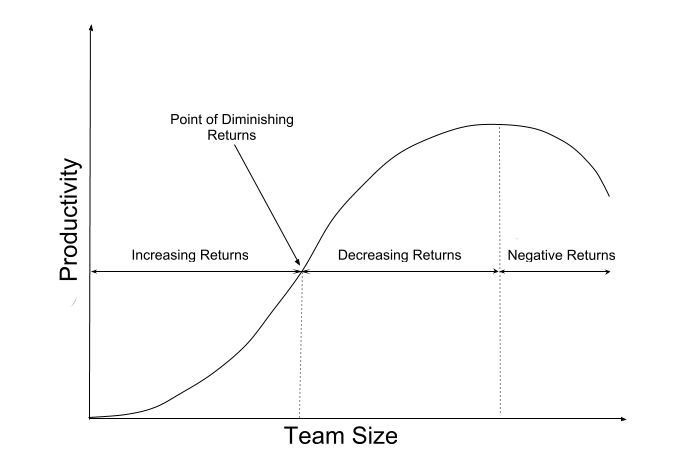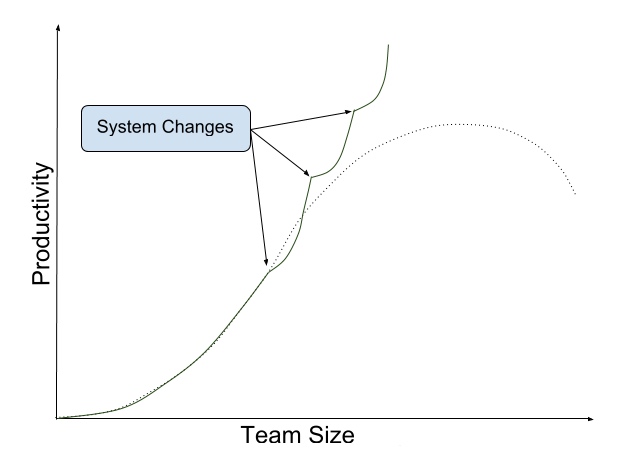It is common for people to think that all project-related problems will be solved if you hire more people. Some even think that, if you are doing X per week, and you double the number of people in your team, you’ll deliver 2X per week.

Before we explain in details why that is not true, we need to introduce a microeconomics law: The Law of Diminishing Returns. Don’t get discouraged by the “microeconomics” word… It will be fast and painless. 😉
Law of Diminishing Returns
Increase in process productivity is not directly proportional to the increase of people in the team. That happens because there is a limited number of ways to increase work parallelism (sometimes there is not a way to divide the tasks that are being held in more tasks), and because each additional worker may actually harm the team’s organization.

When a new person enters the team, the following results may be noticed:
- The team may actually need more capacity and, therefore, the throughput will increase a lot and the return on the investment will be fast reached — increasing returns.
-
The team can still absorb an extra person, but the throughput gained with the addition is low, resulting on long term returns — decreasing returns.
-
The team is saturated and the new teammate makes everyone compete for tasks and invest extra time to coordinate the activities, which causes a decrease in the team’s throughput — negative returns.
What you are saying then is that I can’t do anything to improve my process throughput? 🤔
No! There is a workaround to that law, and we’ll show you how to do it. 😉
Workaround
The diminishing returns curve has as a premise: you set the variables around your system, and you are only changing the amount of people. Therefore, if you change other variables, you may be able to stay longer in the increasing returns area.

These changes will not only make it more appropriate for people to join your team, but it may improve its throughput even if no one is hired as well.
First, you should see if you are following a healthy process. We have a great blog post that summarizes how to improve your workflow: 5 Strategies to improve software development workflow
Second, to make sure you’ll get 100% of efficiency from the new hire, your project may need these characteristics:
- High quality code – if the code quality is bad, the addition of a new member will not change anything. The learning curve to develop new functionalities will be steep and the lead time will only increase with time, due to the complexity generated by the low quality.
-
Software architecture – the software architecture needs to enable the addition of a new member without harming the global throughput.
-
Team organization – the team needs to be correctly organized in order to not destabilize the team’s functioning with the addition. This includes keeping an eye on process bottlenecks to make sure everyone is working on the task that helps the process flow the most.
-
Software documentation – the team needs a good documentation of the existing code so new members can understand the context faster and start working more efficiently right away.
To illustrate this whole idea of diminishing returns and changes in the system, we present a simple, and maybe even a little dumb, example.
Example
To easily understand what people saturation means in a team, imagine that John works selling hotdogs, with a hotdog cart, at a very busy avenue.
He takes care of assembling the hot dogs as well as handling the cash. Since he has a huge line waiting in front of the cart, he often sees people leaving the line to eat elsewhere. Based on that fact, he decides to hire one more person to take care of the hotdog assembly, and he would only take care of the cash.
After the arrival of the new member, sales increase more than 100%, because no one is leaving the queue anymore (example of increasing returns).
However, John believes that one more member would still benefit the business, because the new person could clean the leftovers, so the assembler would be only focused in the assembly process. With that improvement, he is hoping to be fast enough to eliminate the line. Hence, John hires a new person and his revenue increases by 25%, instead of the 100% seen before (example of decreasing returns).
But John still feels that the assembler spends too much time customizing each hotdog according to the customer’s taste. Therefore, he brings one more person to the team to handle the customization. However, with the new person, he sees his productivity decrease in 30%, and notices that the new member started to dispute space with the assembler and the cleaner. He disturbed the process more than helped the flow (example of negative returns).
Nonetheless, John is a visionary and wants to grow his business. To accommodate 4 people and improve the flow even more, he decides to open a hotdog brick-and-mortar store. Now, he has enough space for everyone to work together, and even hires more people as waiters. With the new store, John’s revenue increases in 600% (example of changes in the system to maintain increasing returns).
Conclusion
It is necessary that, before making decisions about hiring or moving in someone new, you are aware of the team’s conditions so you know if the arrival of a new member will bring positive results or not.
What did you think about this post? Did you already know about diminishing returns? Leave your comment below!
